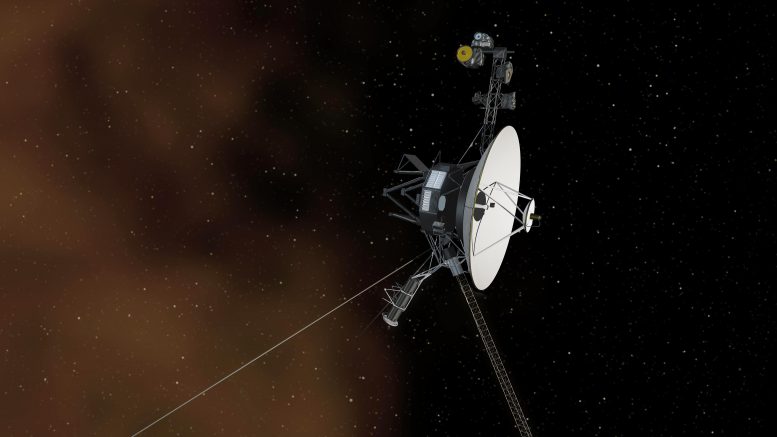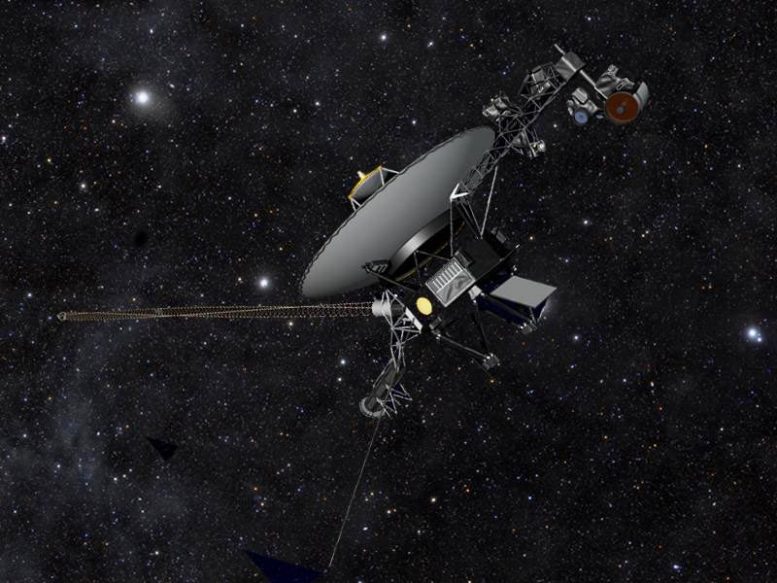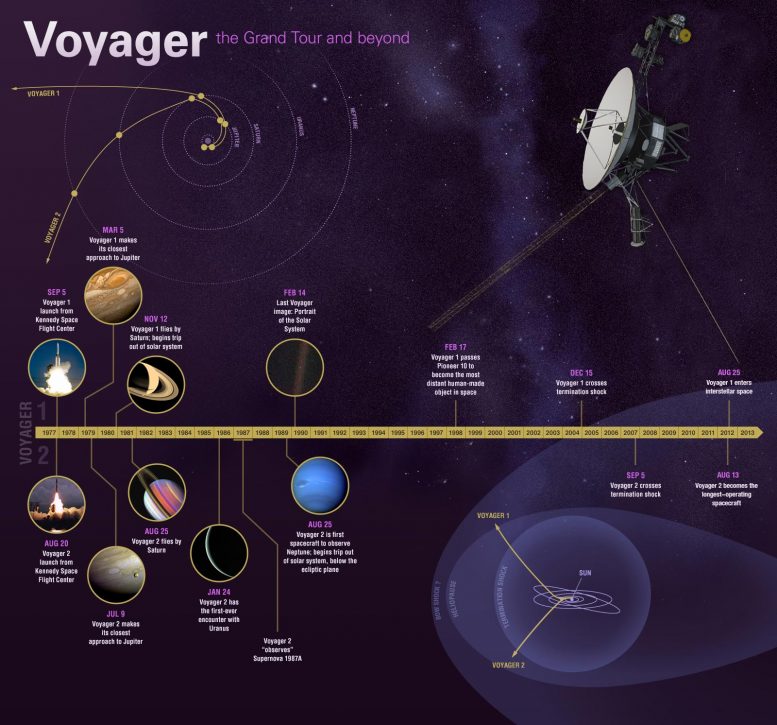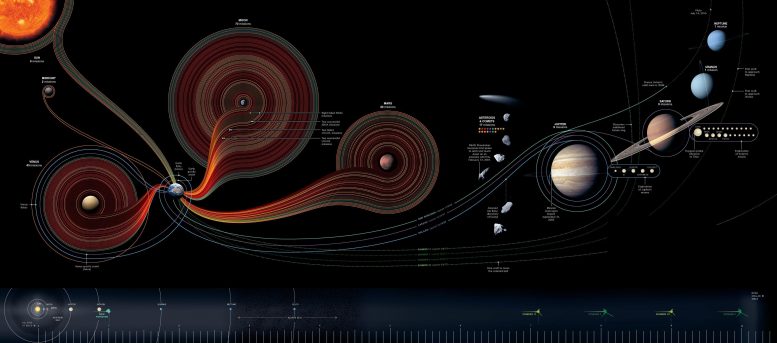In the Emptiness of Space 14 Billion Miles Away, Voyager I Detects “Hum” From Plasma Waves
- Get link
- X
- Other Apps
TOPICS:AstronomyAstrophysicsCornell UniversityNASAPopularVoyagerVoyager 1
By CORNELL UNIVERSITY MAY 10, 2021

This artist’s concept depicts NASA’s Voyager 1 spacecraft entering interstellar space, or the space between stars. Interstellar space is dominated by the plasma, or ionized gas, that was ejected by the death of nearby giant stars millions of years ago. The environment inside our solar bubble is dominated by the plasma exhausted by our sun, known as the solar wind. The interstellar plasma is shown with an orange glow similar to the color seen in visible-light images from NASA’s Hubble Space Telescope that show stars in the Orion nebula traveling through interstellar space. Credit: NASA/JPL-Caltech
Voyager 1 — one of two sibling NASA spacecraft launched 44 years ago and now the most distant human-made object in space — still works and zooms toward infinity.
The craft has long since zipped past the edge of the solar system through the heliopause — the solar system’s border with interstellar space — into the interstellar medium. Now, its instruments have detected the constant drone of interstellar gas (plasma waves), according to Cornell University-led research published in Nature Astronomy.
Examining data slowly sent back from more than 14 billion miles away, Stella Koch Ocker, a Cornell doctoral student in astronomy, has uncovered the emission. “It’s very faint and monotone, because it is in a narrow frequency bandwidth,” Ocker said. “We’re detecting the faint, persistent hum of interstellar gas.”
This work allows scientists to understand how the interstellar medium interacts with the solar wind, Ocker said, and how the protective bubble of the solar system’s heliosphere is shaped and modified by the interstellar environment.

This artist’s concept shows NASA’s Voyager spacecraft against a field of stars in the darkness of space. The two Voyager spacecraft are traveling farther and farther away from Earth, on a journey to interstellar space, and will eventually circle around the center of the Milky Way galaxy. Credit: NASA/JPL-Caltech
Launched in September 1977, the Voyager 1 spacecraft flew by Jupiter in 1979 and then Saturn in late 1980. Traveling at about 38,000 mph, Voyager 1 crossed the heliopause in August 2012.
After entering interstellar space, the spacecraft’s Plasma Wave System detected perturbations in the gas. But, in between those eruptions — caused by our own roiling sun — researchers have uncovered a steady, persistent signature produced by the tenuous near-vacuum of space.
“The interstellar medium is like a quiet or gentle rain,” said senior author James Cordes, the George Feldstein Professor of Astronomy. “In the case of a solar outburst, it’s like detecting a lightning burst in a thunderstorm and then it’s back to a gentle rain.”
Ocker believes there is more low-level activity in the interstellar gas than scientists had previously thought, which allows researchers to track the spatial distribution of plasma — that is, when it’s not being perturbed by solar flares.
Cornell research scientist Shami Chatterjee explained how continuous tracking of the density of interstellar space is important. “We’ve never had a chance to evaluate it. Now we know we don’t need a fortuitous event related to the sun to measure interstellar plasma,” Chatterjee said. “Regardless of what the sun is doing, Voyager is sending back detail. The craft is saying, ‘Here’s the density I’m swimming through right now. And here it is now. And here it is now. And here it is now.’ Voyager is quite distant and will be doing this continuously.”
Voyager 1 left Earth carrying a Golden Record created by a committee chaired by the late Cornell professor Carl Sagan, as well as mid-1970s technology. To send a signal to Earth, it took 22 watts, according to NASA’s Jet Propulsion Laboratory. The craft has almost 70 kilobytes of computer memory and — at the beginning of the mission — a data rate of 21 kilobits per second.
Due to the 14-billion-mile distance, the communication rate has since slowed to 160-bits-per-second, or about half a 300-baud rate.
Reference: “Persistent plasma waves in interstellar space detected by Voyager 1” by Stella Koch Ocker, James M. Cordes, Shami Chatterjee, Donald A. Gurnett, William S. Kurth and Steven R. Spangler, 10 May 2021, Nature Astronomy.
DOI: 10.1038/s41550-021-01363-7
NASA, the Jet Propulsion Laboratory and the National Science Foundation supported the work. Cordes, Chatterjee and Ockler are members of Cornell’s Carl Sagan Institute.
We recommend
- Voyager 2 Illuminates Boundary of Interstellar Space 11 Billion Miles From EarthMike ONeill, SciTechDaily, 2019
- It's Official - Voyager 1 Has Entered Interstellar SpaceStaff, SciTechDaily, 2013
- New Data Confirms that Voyager 1 is in Interstellar SpaceJames Kelly, SciTechDaily, 2014
- NASA Voyager 2 Nearing Interstellar Space, Measures Increase in Cosmic RaysJames Kelly, SciTechDaily, 2018
- Unique Physics in Interstellar Space: Voyager Spacecraft Detect New Type of Solar Electron BurstMike ONeill, SciTechDaily, 2020
- News Feature: Voyager still breaking barriers decades after launchKen Croswell, Proc Natl Acad Sci U S A, 2021
- Infinite-order perturbative treatment for quantum evolution with exchangeJacob R. Lindale et al., Sci Adv, 2020
- Voyage of DiscoveryBrooks Hanson, Science, 2005
- Cassini enters Saturn's ionosphereKeith T. Smith et al., Science, 2018
- Neutral component of the local interstellar mediumWojciech Konior et al., Aircraft Engin and Aeros Techn, 2019


Comments
Post a Comment